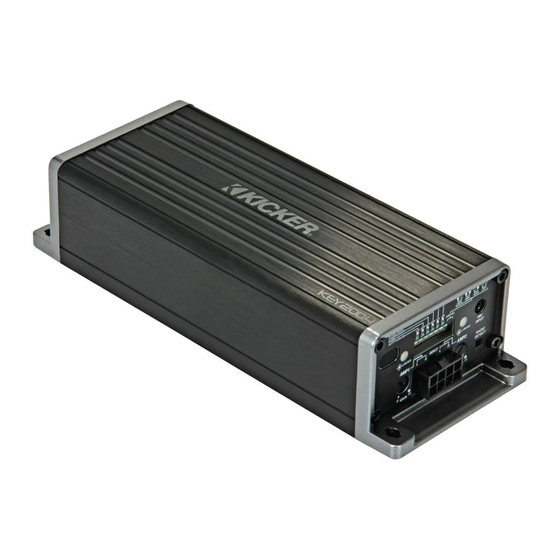Advertisement
KEY200.4 Smart 4-Ch. Amplifier (auto-EQ/processor)
Features:
o 50 watts x 4 at 4Ω.
o Compatible with start/stop vehicles.
o Two-stage power supply for extremely efficient and cool operation.
o Fully automatic DSP setup for EQ, level, and time alignment.
o User-selectable, high-pass crossovers for amp 1 and amp 2 independently.
o User-selectable, bi-amp mode for component sets.
o User-selectable KICKER EQ circuit.
o User-selectable compression circuit.
o 12 volt or auto turn-on with DC offset sensing.
o Included set-up microphone and button.
The KEY200.4 amplifier is a very unique DSP amplifier. It is capable of measuring the audio output
of a 4-speaker, full-range system or a component set consisting of two tweeters and two midranges to
determine if any tone settings, level settings, and time-delay settings could be improved upon for better
tonal balance and enhanced imaging. This process is accomplished by analyzing the audio output of the
existing audio system with the included microphone while playing uncompressed pink noise from the
source unit. It takes the analog signal it has measured and converts it to the digital domain where can be
fine-tuned (patent pending) before it is converted back to analog and amplified.
To run the setup procedure, the amplifier must be completely connected, DIP switches should be
in the proper configuration for that particular set up, and all of the KEY's output channels tested for output
at low levels. All speakers not connected to the KEY amplifier must be disconnected or turned off before
test begins. The microphone should be temporarily mounted on top of the driver's head rest with the
microphone pointing straight up toward the headliner of the vehicle. Turn on the existing stereo system
and make sure the KEY200.4 is also powered on. The source unit in the vehicle should be playing an
uncompressed pink noise recording at a moderate volume from CD, SD card, or auxiliary input source. In
this mode, it will automatically compensate for any factory-programmed equalization. One click of the
setup switch will start the tuning process. Once the button is pushed you will have 10 seconds to exit
vehicle. For best results, the vehicle should be in a quiet environment to prevent outside noises from
degrading the tuning. The KEY200.4 will follow the following set up processes:
4-channel full-range speaker system set up:
For proper automatic setup, make sure all windows and doors are shut and make sure you are in
a quiet environment so outside noises will not adversely affect tuning and set up. This will be especially
important with cars with a convertible top. Make sure all speakers are unobstructed and all of the tone
settings, loudness, balance, fader, crossovers, listing position are in the "off" position on the source unit.
WHITE PAPER
Advertisement
Table of Contents

Subscribe to Our Youtube Channel
Summary of Contents for Kicker KEY200.4
- Page 1 Turn on the existing stereo system and make sure the KEY200.4 is also powered on. The source unit in the vehicle should be playing an uncompressed pink noise recording at a moderate volume from CD, SD card, or auxiliary input source. In this mode, it will automatically compensate for any factory-programmed equalization.
- Page 2 When in bi-amp mode: The KICKER KEY200.4 can also be used to set up and optimize a bi-amp system if you are powering the midranges and tweeters of a component speaker system separately. It will also do the same for wider bandwidth dash speakers (such as 3 ½”, 4”, 4 x 6”, 5 ¼”...
- Page 3 6. Next it will match the levels of the left and right channels. 7. Once the signal is optimized, you can then choose to defeat the KICKER EQ curve for a flatter response. You can also engage the compressor circuit to eliminate distortion caused by clipping (overdriving) the amplifier.
















Need help?
Do you have a question about the KEY200.4 and is the answer not in the manual?
Questions and answers